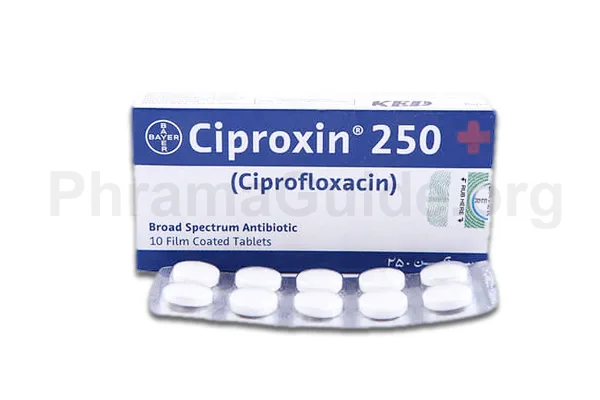Ciproxin tablet is a broad-spectrum antibiotic that is used to treat a variety of bacterial infections. It belongs to the fluoroquinolone class of antibiotics. Following are some common uses of Ciproxin Tablet:
- Urinary Tract Infections (UTIs): Ciproxin tablet is often used to treat uncomplicated UTIs caused by susceptible bacteria, including Escherichia coli (E. coli), which is the most common bacteria associated with UTIs.
- Respiratory Tract Infections: Ciproxin tablets can be used to treat respiratory tract infections such as acute bronchitis, chronic bronchitis, pneumonia, and certain types of bacterial sinusitis.
- Skin and Soft Tissue Infections: Using Ciproxin tablet is effective against various skin and soft tissue infections, including cellulitis, wound infections, and abscesses caused by susceptible bacteria.
- Bone and Joint Infections: Ciproxin tablets may be used to treat bone and joint infections, including osteomyelitis (bone infection) and septic arthritis (joint infection).
- Gastrointestinal Infections: Ciproxin tablet is sometimes used to treat bacterial gastrointestinal infections, such as traveler’s diarrhea, caused by enterotoxigenic E. coli or other susceptible pathogens.
- Sexually Transmitted Infections (STIs): Ciproxin tablets can be used to treat certain sexually transmitted infections, including uncomplicated gonorrhea caused by Neisseria gonorrhoeae.
- Anthrax Exposure: Ciproxin tablet is an antibiotic of choice for post-exposure prophylaxis and treatment of inhalational anthrax, which is caused by Bacillus anthracis.
Off-label Uses of Ciproxin Tablet
- Chronic Prostatitis: Ciproxin tablet is sometimes used off-label to treat chronic bacterial prostatitis, a condition characterized by recurrent or persistent infection of the prostate gland.
- Diverticulitis: In some cases, Ciproxin tablets may be used off-label in the treatment of uncomplicated diverticulitis, an inflammation or infection of small pouches (diverticula) that form in the wall of the colon.
- Community-Acquired Pneumonia (CAP): Ciproxin tablets may be used off-label in the treatment of community-acquired pneumonia caused by certain susceptible bacteria.
- Tuberculosis: Ciproxin tablet is sometimes used as part of a multidrug regimen for the treatment of drug-resistant tuberculosis, particularly when other drugs are not effective or cannot be tolerated.
- Sinusitis: Although not commonly used, Ciproxin tablets may be used for the treatment of bacterial sinusitis in certain cases where other antibiotics have failed or are not suitable.

What is Ciproxin?
Ciproxin is a research brand of Ciprofloxacin, manufactured and marketed by Bayer Schering Pharma.
Ciproxin Alternatives : Other Similar Brands
The Following are some available alternative brands of Ciproxin and their manufacturers.
- Novidat : Sami Pharmaceuticals (Pvt) Ltd, Pakistan.
- Cipesta : Getz Pharmaceuticals (Pvt) Ltd, Pakistan.
- Cycin : High Q Pharmaceuticals (Pvt) Ltd, Pakistan.
- Ciplet : Indus Pharma (Pvt) Ltd, Pakistan.
- Lucid : Saffron Pharmaceuticals (Pvt) Ltd, Pakistan.
- Mercip : Martin Dow Marker, Pakistan.
- Hiflox : Hilton Pharmaceuticals (Pvt) Ltd, Pakistan.
- Mytil : Wilsons Pharmaceuticals (Pvt) Ltd, Pakistan.
- Hipro : Helix Pharma (Pvt) Ltd, Pakistan.
- Ciproquine : Macter International.
- Algocin : AGP Pharma, Pakistan.
Ciproxin : Available Formulations and Strengths
Presently, Ciproxin is available in Tablet and Infusion Forms with the following strengths.
Ciproxin Tablets : 100mg, 250mg, and 500mg strengths.
Ciproxin Infusion : 200mg/100ml strength.
Who Should Not Use Ciproxin?
Ciproxin has several contraindications, which are medical conditions or situations where the use of Ciproxin is not recommended due to the potential risks outweighing the benefits.
Hypersensitivity: Ciproxin is contraindicated in individuals who have a known hypersensitivity or allergy to Ciproxin or any other fluoroquinolone antibiotics. Allergic reactions can range from mild skin reactions to severe allergic reactions, including anaphylaxis, which is a potentially life-threatening condition.
Tendonitis and Tendon Rupture: Ciproxin is contraindicated in patients with a history of tendon disorders, such as tendonitis or tendon rupture, associated with fluoroquinolone use. There is an increased risk of tendon inflammation and tendon rupture, particularly in the Achilles tendon.
Myasthenia Gravis: Ciproxin is contraindicated in individuals with a history of myasthenia gravis, a neuromuscular disorder characterized by muscle weakness. Fluoroquinolones can worsen muscle weakness and potentially lead to a myasthenia gravis crisis.
Children and Adolescents: Ciproxin is generally contraindicated in children and adolescents under 18 years of age, as it may impair the development of bones, joints, and other tissues. However, it may be used in certain circumstances when other treatment options are not suitable.
Pregnancy and Breastfeeding: Ciproxin is contraindicated during pregnancy and breastfeeding due to potential harm to the developing fetus or nursing infant. It may interfere with bone development and cause adverse effects.
Seizure Disorders: Ciproxin is contraindicated in individuals with a history of seizures or epilepsy, as it can lower the seizure threshold and increase the risk of seizures.
What is the Recommended Daily Dosage of Ciproxin?
Ciproxin Dose for Uncomplicated Urinary Tract Infections (UTIs):
- One Tablet of 250mg twice daily for 3 days.
Ciproxin Dose for Complicated Urinary Tract Infections and Other Infections:
- One Tablet of 500mg twice daily.
Ciproxin Dose for Skin and Soft Tissue Infections:
- One Tablet of 500mg twice daily.
Ciproxin Dose for Bone and Joint Infections:
- One Tablet of 500mg twice daily.
Ciproxin Dose for Severe or Life-Threatening Infections:
- In such cases, higher doses may be required.
- 750mg to 1000mg twice daily.
How Ciproxin Works?
Ciproxin is a broad-spectrum antibiotic that belongs to the fluoroquinolone class of drugs. It exerts its mode of action by inhibiting the bacterial enzymes called DNA gyrase and topoisomerase IV. These enzymes are responsible for the supercoiling and uncoiling of DNA during replication, transcription, and repair processes in bacteria.

Leave A Comment